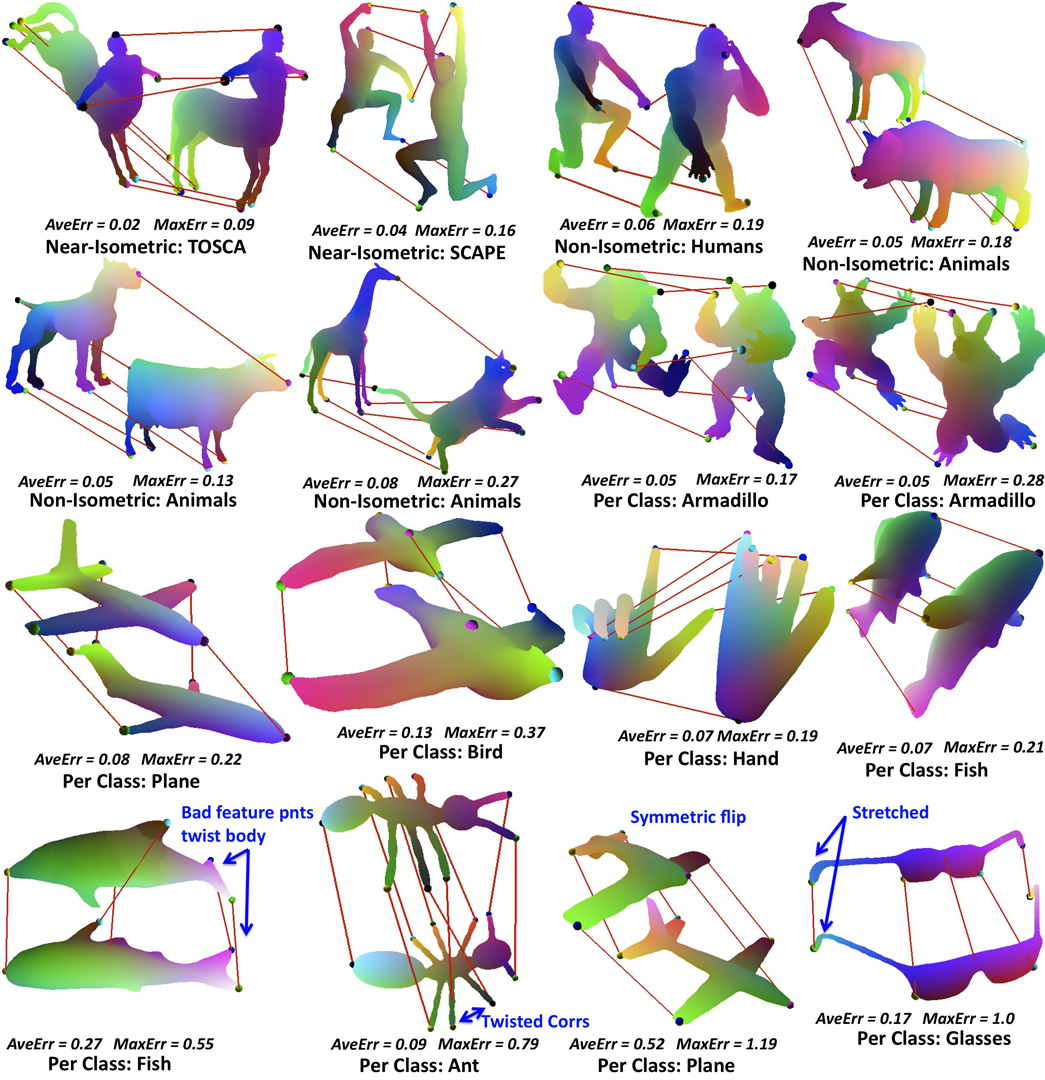“Blended intrinsic maps” by Kim, Lipman and Funkhouser
Conference:
Type(s):
Title:
- Blended intrinsic maps
Presenter(s)/Author(s):
Abstract:
This paper describes a fully automatic pipeline for finding an intrinsic map between two non-isometric, genus zero surfaces. Our approach is based on the observation that efficient methods exist to search for nearly isometric maps (e.g., Möbius Voting or Heat Kernel Maps), but no single solution found with these methods provides low-distortion everywhere for pairs of surfaces differing by large deformations. To address this problem, we suggest using a weighted combination of these maps to produce a “blended map.” This approach enables algorithms that leverage efficient search procedures, yet can provide the flexibility to handle large deformations.The main challenges of this approach lie in finding a set of candidate maps {mi} and their associated blending weights {bi(p)} for every point p on the surface. We address these challenges specifically for conformal maps by making the following contributions. First, we provide a way to blend maps, defining the image of p as the weighted geodesic centroid of mi(p). Second, we provide a definition for smooth blending weights at every point p that are proportional to the area preservation of mi at p. Third, we solve a global optimization problem that selects candidate maps based both on their area preservation and consistency with other selected maps. During experiments with these methods, we find that our algorithm produces blended maps that align semantic features better than alternative approaches over a variety of data sets.
References:
1. Alexa, M. 2001. Recent advances in mesh morphing. Computer Graphics Forum 21, 2, 173–198.Google ScholarCross Ref
2. Allen, B., Curless, B., and Popović, Z. 2003. The space of all body shapes: reconstruction and parameterization from range scans. ACM Transactions on Graphics (proc. SIGGRAPH). Google Scholar
3. Anguelov, D., Srinivasan, P., Koller, D., Thrun, S., Pang, H., and Davis, J. 2004. The correlated correspondence algorithm for unsupervised registration of nonrigid surfaces. Proc. of the Neural Information Processing Systems.Google Scholar
4. Besl, P., and McKay, N. 1992. A method for registration of 3-d shapes. IEEE Trans. on Pattern Analysis and Machine Intelligence (PAMI). Google Scholar
5. Bronstein, A. M., Bronstein, M. M., and Kimmel, R. 2006. Generalized multidimensional scaling: a framework for isometry-invariant partial surface matching. Proc. National Academy of Sciences (PNAS).Google Scholar
6. Bronstein, A. M., Bronstein, M. M., and Kimmel, R. 2008. Numerical geometry of non-rigid shapes. Springer. Google Scholar
7. Brown, B. J., and Rusinkiewicz, S. 2007. Global non-rigid alignment of 3-d scans. ACM Transactions on Graphics (Proc. SIGGRAPH). Google Scholar
8. Chang, W., Li, H., Mitra, N., Pauly, M., and Wand, M. 2010. Geometric registration for deformable shapes. Eurographics 2010 course.Google Scholar
9. Eldar, Y., Lindenbaum, M., Porat, M., and Zeevi, Y. 1997. The farthest point strategy for progressive image sampling. mover’s distance as a metric for image retrieval. Int. J. Comput. Vision 40, 2, 99–121. Google Scholar
10. Funkhouser, T., and Shilane, P. 2006. Partial matching of 3d shapes with priority-driven search. Symp. on Geom. Processing. Google ScholarDigital Library
11. Gelfand, N., Mitra, N. J., Guibas, L., and Pottmann, H. 2005. Robust global registration. Symp. on Geom. Processing. Google ScholarDigital Library
12. Ghosh, D., Sharf, A., and Amenta, N. 2009. Feature-driven deformation for dense correspondence. Proc. SPIE 7261.Google Scholar
13. Giorgi, D., Biasotti, S., and Paraboschi, L. 2007. Shrec:shape retrieval contest: Watertight models track. http://watertight.ge.imati.cnr.it/.Google Scholar
14. Golovinskiy, A., and Funkhouser, T. 2009. Consistent segmentation of 3D models. Computers and Graphics (Shape Modeling International 09) 33, 3 (June), 262–269. Google Scholar
15. Huang, Q., Adams, B., Wicke, M., and Guibas, L. J. 2008. Non-rigid registration under isometric deformations. Computer Graphics Forum (Proc. SGP 2008). Google ScholarDigital Library
16. Kim, V. G., Lipman, Y., Chen, X., and Funkhouser, T. 2010. Mobius transformations for global intrinsic symmetry analysis. Computer Graphics Forum (Proc. of SGP).Google Scholar
17. Kraevoy, V., and Sheffer, A. 2004. Cross-parameterization and compatible remeshing of 3d models. ACM Transactions on Graphics (Proc. SIGGRAPH 2004). Google Scholar
18. Li, H., Sumner, R. W., and Pauly, M. 2008. Global correspondence optimization for non-rigid registration of depth scans. Computer Graphics Forum (Proc. SGP’08). Google ScholarDigital Library
19. Lipman, Y., and Funkhouser, T. 2009. Mobius voting for surface correspondence. ACM Transactions on Graphics (Proc. SIGGRAPH) 28, 3 (Aug.). Google ScholarDigital Library
20. Mémoli, F., and Sapiro, G. 2004. Comparing point clouds. In SGP ’04: Proceedings of the 2004 Eurographics/ACM SIGGRAPH symposium on Geometry processing. Google Scholar
21. Ovsjanikov, M., Mérigot, Q., Mémoli, F., and Guibas, L. 2010. One point isometric matching with the heat kernel. In Computer Graphics Forum (Proc. of SGP).Google Scholar
22. Pauly, M., Mitra, N. J., Giesen, J., Gross, M., and Guibas, L. 2005. Example-based 3d scan completion. In Symposium on Geometry Processing, 23–32. Google ScholarDigital Library
23. Pinkall, U., and Polthier, K. 1993. Computing discrete minimal surfaces and their conjugates. Experimental Mathematics 2, 15–36.Google ScholarCross Ref
24. Praun, E., Sweldens, W., and Schröder, P. 2001. Consistent mesh parameterizations. Proc. of SIGGRAPH 2001. Google Scholar
25. Schreiner, J., Asirvatham, A., Praun, E., and Hoppe, H. 2004. Inter-surface mapping. ACM Transactions on Graphics (Proc. SIGGRAPH). Google Scholar
26. Tevs, A., Bokeloh, M., M. Wand, Schilling, A., and Seidel, H.-P. 2009. Isometric registration of ambiguous and partial data. In: Proc. IEEE Conference on Computer Vision and Pattern Recognition.Google Scholar
27. van Kaick, O., Zhang, H., Hamarneh, G., and Cohen-Or, D. 2010. A survey on shape correspondence. Eurographics State-of-the-Art report.Google Scholar
28. Zhang, H., Sheffer, A., Cohen-Or, D., Zhou, Q., van Kaick, O., and Tagliasacchi, A. 2008. Deformation-driven shape correspondence. Computer Graphics Forum (Proc. of SGP). Google Scholar




